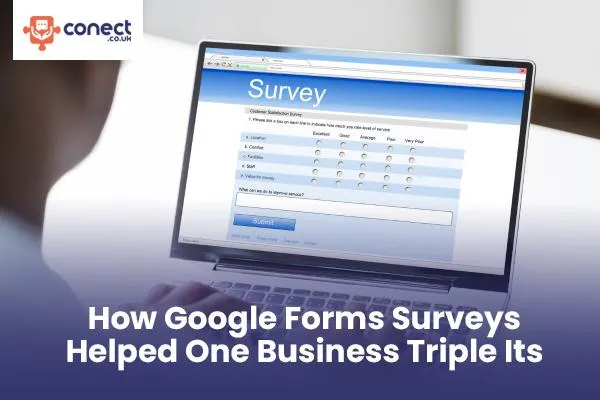
Best Google Forms Survey to Help One Business Triple Feedback
How Google Forms Surveys Helped One Business Triple Its Customer Feedback?
Collecting customer feedback is essential for any business striving for improvement and growth. However, obtaining valuable insights from your audience can be a challenging and time-consuming process without the right tools. Many businesses have found that surveys provide an effective solution, but the key is using the right platform. Google Forms surveys, in particular, have proven to be a game-changer for businesses looking to gather valuable feedback efficiently.
In this post, we will explore how one company leveraged the power of Google Forms to not only streamline their feedback collection process but also triple the amount of data they were receiving from customers. From improved engagement to data analysis, the impact of utilizing this simple yet powerful tool cannot be overstated.
Streamlining Feedback Collection with Google Forms Surveys
Before adopting Google Forms for customer feedback, the business in question was struggling to maintain consistent engagement with their customers. Traditional feedback methods, such as email surveys or in-person questionnaires, proved to be ineffective in reaching a broad audience. Response rates were low, and it was difficult to analyze the collected data in a meaningful way.
By transitioning to Google Forms surveys, the business was able to overcome these challenges. The platform offered a user-friendly interface that made it easy for both the company and its customers to interact. This transition not only simplified the feedback process but also provided several key advantages over their previous methods.
Why Choose Google Forms for Feedback Collection?
Ease of Use: Google Forms is designed to be intuitive, allowing users to create customized surveys in a matter of minutes. No technical expertise is needed, making it accessible for businesses of all sizes.
Customizable Templates: Google Forms provides a variety of pre-designed templates, which makes creating surveys even quicker. Additionally, businesses can fully customize the survey to meet their specific needs, ensuring the questions align with their objectives.
Real-Time Data Collection: Unlike other feedback methods that require manual data entry, Google Forms automatically collects and organizes responses in real-time. This allows businesses to analyze feedback as it comes in, providing immediate insights.
Cost-Effective: As a free tool, Google Forms offers immense value without the need for an expensive survey platform. This makes it especially appealing for small businesses or startups looking to save on overhead costs.
Triple Your Customer Feedback: How One Business Achieved It
The business we’re discussing realized early on that Google Forms surveys could provide the perfect solution to their low engagement rates. After making the switch, the company implemented a strategic approach that led to a significant increase in the amount of customer feedback they received.
1. Strategic Survey Design for Maximum Engagement
The first step the business took was designing surveys that were engaging and relevant to their customers. They focused on ensuring the questions were straightforward and easy to answer, eliminating any unnecessary complexity.
The company used a mix of question types, including multiple choice, Likert scales, and short-answer questions, to maintain variety and keep customers engaged. By limiting the survey to a manageable number of questions (around 10-15), the business found that customers were more likely to complete the survey in full.
2. Targeted Distribution Channels
The next step in their strategy was determining the best distribution channels to reach their customers. The business distributed the surveys through several touchpoints, including:
Email Newsletters: The company included a link to the survey in their regular email communications, which reached a large portion of their customer base.
Social Media: By sharing the survey on their social media platforms, they were able to attract a broader audience, including customers who might not be on their email list.
Website Pop-ups: Placing survey invitations as pop-ups on their website helped capture feedback from customers already engaged with their content.
The multiple distribution channels ensured that the survey reached a diverse range of customers, increasing the response rate.
3. Incentivizing Participation
One key factor that contributed to the significant increase in feedback was the business's decision to offer incentives for completing the survey. Customers who took the time to provide feedback were entered into a prize draw for a gift card or product discount. This incentivization led to higher participation rates, which ultimately helped the business gather more valuable data.
4. Quick and Simple Surveys for Busy Customers
The business ensured that the surveys were quick and easy to complete, respecting their customers’ time. In the fast-paced world of today’s digital age, customers appreciate brevity. Surveys that took less than five minutes to complete saw the highest response rates.
Data Analysis and Actionable Insights
After implementing their Google Forms surveys, the business saw a remarkable improvement in the quantity and quality of the feedback they received. The next challenge was making sense of the data to gain actionable insights. This is where the integration of Google Forms with other tools, such as Google Sheets, became invaluable.
Automated Data Collection and Analysis
With Google Forms, survey responses were automatically populated into Google Sheets. The business could then use built-in analytics tools to quickly identify trends and patterns in the responses. For instance:
Customer Satisfaction Scores: By using Likert scale questions, the business was able to track satisfaction levels over time and identify areas where they needed improvement.
Product Feedback: Responses about specific products allowed the company to pinpoint strengths and weaknesses, helping them prioritize which products to improve or discontinue.
Demographic Insights: By including demographic questions, the company was able to tailor their marketing efforts to specific customer segments.
The ease of data analysis with Google Forms made it possible for the business to adapt quickly based on customer feedback, helping them stay competitive in the marketplace.
Continuous Improvement: Building Customer Trust and Loyalty
The benefits of using Google Forms surveys didn’t stop with increased feedback volume. The business also discovered that regularly collecting customer opinions allowed them to build stronger relationships with their audience. Customers felt more valued when they saw that their feedback led to tangible changes.
1. Customer-Centric Decision-Making
By making decisions based on real customer input, the business demonstrated that they truly cared about their customers' needs. This transparency helped strengthen customer trust and loyalty.
2. Showcasing Improvements to Customers
The business regularly communicated the improvements they made as a result of customer feedback. For instance, if a product feature was adjusted based on survey responses, they would let customers know through email newsletters and social media. This not only improved customer satisfaction but also increased engagement with future surveys, as customers wanted to be part of the decision-making process.
3. Long-Term Relationship Building
By continuously gathering feedback and making improvements, the business was able to establish a long-term relationship with their customers. Customers who saw that their input mattered were more likely to continue supporting the business, leading to higher retention rates.
Final Thoughts
The success story of how one business tripled its customer feedback using Google Forms surveys highlights the power of simplicity and accessibility in data collection. By designing engaging, easy-to-complete surveys, distributing them through multiple channels, and offering incentives, the business was able to gain valuable insights that informed their decision-making process.
With Google Forms' seamless data collection and analysis features, businesses of all sizes can use surveys to gather customer feedback and drive meaningful improvements. If you’re looking for a simple, affordable, and effective way to engage with your customers and make data-driven decisions, using Google Forms surveys could be the solution you need.
Frequently Asked Questions
1. What are the benefits of using Google Forms for surveys?
Google Forms is an easy-to-use, free tool that allows businesses to quickly create and distribute surveys, streamlining data collection and analysis.
2. How can a survey tool help increase customer feedback?
Survey tools like Google Forms provide a seamless way to engage customers and gather feedback by making surveys simple and convenient.
3. How do I design a customer survey that engages my audience?
Focus on creating short, clear questions with a variety of answer options, and offer incentives for participation to increase engagement.
4. Can I track and analyze responses from Google Forms?
Yes, Google Forms automatically stores responses in Google Sheets, where you can use analytics tools to identify trends and insights.
5. How can surveys help in improving business decisions?
Customer feedback collected through surveys can reveal areas for improvement, allowing businesses to make informed, data-driven decisions.
6. How can I ensure my surveys reach a wide audience?
Distribute your surveys through multiple channels such as email, social media, and your website to maximize exposure and responses.
7. How long should a survey be to get quality feedback?
Keep your surveys between 5 to 10 questions to ensure they’re easy to complete, which will encourage customers to finish them.
8. What types of questions work best for collecting customer feedback?
Use a mix of multiple-choice, Likert scale, and short-answer questions to gather both quantitative and qualitative data.
9. How can incentives boost survey participation?
Offering rewards like discounts or a chance to win a prize motivates customers to participate, leading to higher response rates.
10. How often should I conduct surveys to gather meaningful data?
Conduct surveys regularly, such as quarterly or after major product launches, to maintain continuous customer insights and stay responsive.

The All-In-One Solution to grow your business. Capture Free Leads And Conversationally Covert Them Into Customers!
Contact information
Address : Layton Lane, Rawdon, Leeds, LS19 6RG
Phone : +44 7859 775480
Email : [email protected]
© 2025 Butterfly Effect Marketing Ltd - All Rights Reserved.

